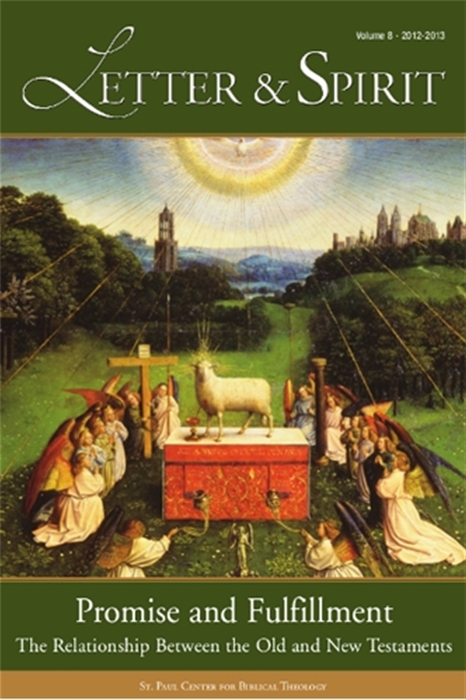Letter & Spirit Vol. 8: Promise and Fulfillment: The Relationship Between the Old and New Testaments makes accessible to clergy, students, and laity the finest Catholic biblical scholarship.
On the day of his resurrection, Jesus’ exposition to two of his disciples on the road to Emmaus (Luke 24:25–27, 32) and shortly afterwards to his eleven apostles and other disciples (Luke 24:44–47) included “all the scriptures” “beginning with Moses and all the prophets.” Implicit and underlying Jesus’ expositions in these two episodes is the idea that a unity of purpose exists throughout the many diverse sacred books of the Old Testament. Jesus discerned there a story line, an orderly plan—a Divine economy—unfolding throughout history and expressed in the inspired record that would culminate in his own saving work.
The idea of typology is implicit and flows from this unified story—this Divine economy—that we find in the Bible. The Scriptures encompass a single story, but it is composed of two parts: the Old Testament and the New. The other New Testament writers follow his example in applying “all the scriptures” to the doctrine of the Church and Christian moral, ascetical, and sacramental life. It is not merely, or even primarily, a correspondence of prediction and fulfillment. It is, rather, a pattern of analogy. What began in the Old Testament is fulfilled partially even within the Old Testament, but definitively in the New, in a way that is both restorative and transformative.
This issue of Letter & Spirit seeks to explain and demonstrate the propriety and necessity of interpreting the Bible using the hermeneutics of the divine economy and typology.
This volume includes:
Articles
- “From Old to New: ‘ Covenant’ or ‘ Testament’ in Hebrews 9?” by Scott W. Hahn
- “Jesus, the Messianic Wedding Banquet, and the Restoration of Israel” by Brant Pitre
- “Matthew as Exegete: The Unity and Function of the Formula Citations in Matthew 1:1-4:16” by Jeremy Holmes
- “The Tradition of Christian Allegory Yesterday and Today”by Leroy A. Huizenga
- “The New Temple, the New Priesthood, and the New Cult in Luke-Acts” by Michael Patrick Barber
- “New Approaches to Marian Typology in Luke 1: Mary as Daughter Zion and Queen Mother” by Edward Sri
- “Qumran and the Concept of Pan Israelite Restoration” by John S. Bergsma
- “Divine Pedagogy and Covenant Memorial: The Catechetical Narratio and the New Evangelization” by Sean Innerst
- “Historical Criticism as Secular Allegorism: The Case of Spinoza” by Jeffrey L. Morrow
- “Purchasing the Rewards of Eternal Life: The Logic of Resurrection and Ransom in Matthew’s Gospel” by Nathan Eubank
Letter & Spirit seeks to foster a deeper conversation about the Bible. This journal of biblical theology, published in collaboration with Scott Hahn and the St. Paul Center for Biblical Theology, takes a crucial step toward recovering the fundamental link between the literary and historical study of Scripture and its religious and spiritual meaning in the Church’ s liturgy and Tradition.
Published annually, the Letter & Spirit journal is essential reading for clergy, students, and laity.



Reviews
There are no reviews yet.